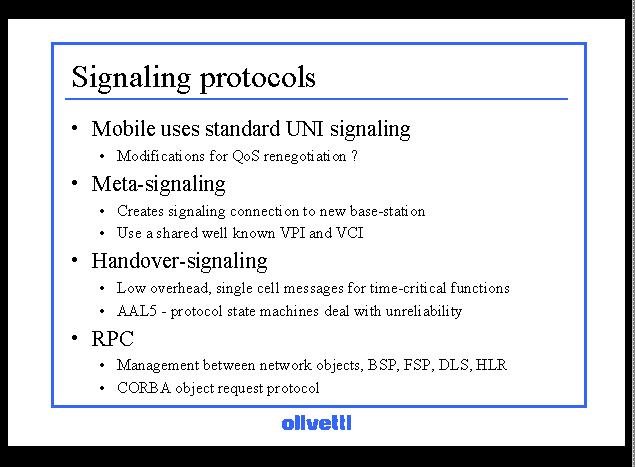 |

|

|

|

|
 |

|

|

|

|
The mobile uses standard UNI signalling, mobility support , is provided using other protocols running in parallel
It is however likely that although we are aiming to provide full support for QoS, the extent to which guarantees can be made in a wireless network is limited. The link quality can vary due to changes in propagation characteristics and the available service can change due to ones own or others mobility. It is likely therefore that some modification to the standard UNI will be required to support re-negotiation of QoS for active connecitions plus the associated application support.
The UNI signaling protocol currently assumes that it runs over a dedicated PVC. In the case of an access-point based system this is not true. All mobiles sharing the same access point share the signaling channel.
VCs from different mobiles are distinguished using VPIs, so a meta-signalling protocol is used to allocate the VPI to a mobile when it arrives in a domain.
The meta-signaling requests are single-cell AAL5 messages which explicity identify the mobile using a unique identifier. (I will talk more about naming and addressing later)
The meta-signaling messages are transmitted on a permanent VP and VC and hence there is possibility for collision and loss of the messages. However, they are only required when a mobile is first handed over to a new domain.
Handover signaling is exchanged over PVCs within the VP between the fixed switching point, the base-station and the mobile. This is a low overhead signaling mechanism used for the time-critical parts of the mobility control and management.
Messages are exchanged using AAL5 and are assumed to be unreliable especially over the wireless link. The higher layer protocol state machines recover from this unreliability rather than requiring a reliable transport protocol. This is because the protocol is required to operate when the link is at its most vulnerable - just before handover - and is required to recover quickly from loss of connectivity.
The most time-critical messages - those associated with handover - are single cell messages. Other messages such as name-registration can be arbitrary (although still only a few cells) length. All messages are fixed format so that protocol processing is minimized.
The communication between DLS, FSP and Base use an RPC mechanism. This means that the management entities can run on servers anywhere in the network.
There are no RPC messages exchanged over the wireless link.